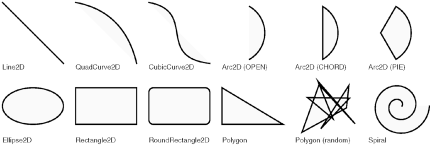12.3 Drawing and Filling Shapes
| Example 12-6 lists a GraphicsExample implementation that shows how various Shape objects can be defined, drawn, and filled. The example produces the output shown in Figure 12-4. Although the Java 2D API allows basic shapes to be drawn and filled using the methods demonstrated in Example 12-1, this example uses a different approach. It defines each shape as a Shape object, using various classes, mostly from java.awt.geom. Each Shape is drawn using the draw( ) method of the Graphics2D class and filled using the fill( ) method. Note that each Shape object is defined with one corner at (or near) the origin, rather than at the location where it is displayed on the screen. This creates position-independent objects that can easily be reused. To draw the shapes at particular locations, the example uses the translate( ) method of Graphics2D to move the origin of the coordinate system. Finally, the call to setStroke( ) specifies that drawing be done with a two-pixel-wide line, while the call to setRenderingHint( ) requests that drawing be done using antialiasing. Figure 12-4. Drawing and filling shapes with the Java 2D API Example 12-6. Shapes.javapackage je3.graphics; import java.awt.*; import java.awt.geom.*; import java.awt.font.*; import java.awt.image.*; /** A demonstration of Java2D shapes */ public class Shapes implements GraphicsExample { static final int WIDTH = 725, HEIGHT = 250; // Size of our example public String getName( ) {return "Shapes";} // From GraphicsExample public int getWidth( ) { return WIDTH; } // From GraphicsExample public int getHeight( ) { return HEIGHT; } // From GraphicsExample Shape[ ] shapes = new Shape[ ] { // A straight line segment new Line2D.Float(0, 0, 100, 100), // A quadratic bezier curve. Two end points and one control point new QuadCurve2D.Float(0, 0, 80, 15, 100, 100), // A cubic bezier curve. Two end points and two control points new CubicCurve2D.Float(0, 0, 80, 15, 10, 90, 100, 100), // A 120 degree portion of an ellipse new Arc2D.Float(-30, 0, 100, 100, 60, -120, Arc2D.OPEN), // A 120 degree portion of an ellipse, closed with a chord new Arc2D.Float(-30, 0, 100, 100, 60, -120, Arc2D.CHORD), // A 120 degree pie slice of an ellipse new Arc2D.Float(-30, 0, 100, 100, 60, -120, Arc2D.PIE), // An ellipse new Ellipse2D.Float(0, 20, 100, 60), // A rectangle new Rectangle2D.Float(0, 20, 100, 60), // A rectangle with rounded corners new RoundRectangle2D.Float(0, 20, 100, 60, 15, 15), // A triangle new Polygon(new int[ ] { 0, 0, 100 }, new int[ ] {20, 80, 80}, 3), // A random polygon, initialized in code below null, // A spiral: an instance of a custom Shape implementation new Spiral(50, 50, 5, 0, 50, 4*Math.PI), }; { // Initialize the null shape above as a Polygon with random points Polygon p = new Polygon( ); for(int i = 0; i < 10; i++) p.addPoint((int)(100*Math.random( )), (int)(100*Math.random( ))); shapes[10] = p; } // These are the labels for each of the shapes String[ ] labels = new String[ ] { "Line2D", "QuadCurve2D", "CubicCurve2D", "Arc2D (OPEN)", "Arc2D (CHORD)", "Arc2D (PIE)", "Ellipse2D", "Rectangle2D", "RoundRectangle2D", "Polygon", "Polygon (random)", "Spiral" }; /** Draw the example */ public void draw(Graphics2D g, Component c) { // Set basic drawing attributes g.setFont(new Font("SansSerif", Font.PLAIN, 10)); // select font g.setStroke(new BasicStroke(2.0f)); // 2 pixel lines g.setRenderingHint(RenderingHints.KEY_ANTIALIASING, // antialiasing RenderingHints.VALUE_ANTIALIAS_ON); g.translate(10, 10); // margins // Loop through each shape for(int i = 0; i < shapes.length; i++) { g.setColor(Color.yellow); // Set a color g.fill(shapes[i]); // Fill the shape with it g.setColor(Color.black); // Switch to black g.draw(shapes[i]); // Outline the shape with it g.drawString(labels[i], 0, 110); // Label the shape g.translate(120, 0); // Move over for next shape if (i % 6 == 5) g.translate(-6*120, 120); // Move down after 6 } } } |
EAN: 2147483647
Pages: 285
- Integration Strategies and Tactics for Information Technology Governance
- Linking the IT Balanced Scorecard to the Business Objectives at a Major Canadian Financial Group
- Measuring ROI in E-Commerce Applications: Analysis to Action
- Technical Issues Related to IT Governance Tactics: Product Metrics, Measurements and Process Control
- Governing Information Technology Through COBIT